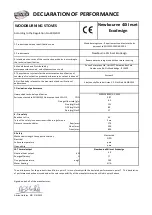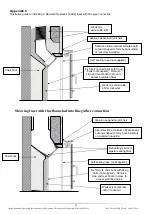
4
Installation and Operating Instructions for Newbourne 40i Inset Inset Ecodesign Multi Fuel Stove
Ref: Pevex1030/AH/ver1: 1 April 2019
USE OF BROWN COAL OR OTHER NON-AUTHORISED FUELS SHOULD NOT BE USED ON THE
APPLIANCE IF LOCATED IN A SMOKE CONTROL AREA UNLESS IT IS PART OF A MANUFACTURED
AUTHORISED FUEL.
It is essential when burning smokeless solid fuels that the ashpan is emptied on a daily basis. Ash must not be
allowed to build up below the grate. Note brown coal and smokeless fuel should also be stored dry and
ventilated.
Use of Petroleum coke, liquid fuels, house coal
and unauthorised fuels
will invalidate the guarantee and
must not be used
as this will cause the stove to “over fire” as well as damaging the internal components.
Operating at temperatures in excess of 500ºC will cause irreparable damage which is not covered by the
guarantee. B
urning any “contaminated” or treated wood which may have been painted, varnished, oiled/stained
or materials such as MDF or plywood which contain resins/glues should never be used as this will cause an
over-fire situation resulting in damage to the glass and bricks not to mention the toxic gases emitted into the
atmosphere. Also, never burn bituminous house coal which is designed for open fires and not for use in stoves
as this fuel is very volatile and gaseous containing lots of sulphur which will
permanently etch marks in the
glass
as well as potential damage to the bricks, baffles and grate.
FUEL CONSUMPTION AT NOMINAL HEAT OUTPUT
Nominal
Output kW
Wood kg/hr
Ancit kg/hr
Newbourne 40i Inset
Ecodesign
4.9
1.1
0.59
Tested according to the requirements of EN13229. Note that different fuel consumption results may be achieved
due to other factors which include the fuel, chimney draught and atmospheric conditions etc.
The nominal output is the output to which the stove has been tested. In practice, the stove burns with a heat
output range between its minimum and maximum ratings.
LIGHTING AND COMBUSTION
The primary air is drawn into the stove through the air slider located on the lower part of the door; slide the knob
to the right to allow air to enter and slide it in to the left to shut off the air supply. Allowing 20% of primary air to
enter is a recommended position during normal operation of the stove after the fire has established in the firebox,
allowing a preset bleed of air to enter. In practice however, you may find it necessary to reduce/increase the air
supply depending on the fuel you are burning and the draught of your chimney.
The secondary air is regulated with the aid of a slider above the door; sliding it to the right increases the air
supply. The he
ated secondary air flows down the viewing window creating an “airwash” to keep the glass clean
and feeding the fire; it is this secondary combustion that completes the burning cycle by turning unburned
volatiles into flame. Finally, any remaining unburnt volatiles are burnt when preheated tertiary air enters the
firebox through the tertiary air holes in the rear bricks.
As much as half of the heat obtainable from wood is achieved from secondary and tertiary combustion. It is
important that the firebox temperature is maintained at a high level as this also aids complete combustion. For
example, when first lighting a stove it is important to get it really hot before closing the burning rate down. The
firebox temperature should reach 400°C which equates to approximately 250 °C at the flue pipe
The Newbourne 40i Inset Ecodesign stove is designed and fully tested to burn extremely cleanly with very little
smoke discharge and exempt for use in smoke control areas throughout the UK when burning dry wood logs. To
comply, a built-in permanent stop is fitted to the secondary air slider so that it cannot be closed completely and
will always allow a preset amount of air to enter. A permanent amount of secondary air must therefore enter the
firebox to feed the fire producing negligible amounts of smoke and unburnt hydrocarbons. The appliances will
only be considered as exempt appliances if this stop on the secondary air slider is in place.

































